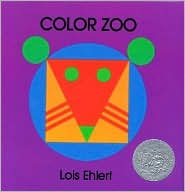
Early Literacy Aside--Explain: The beginning of letter knowledge, one of the six early literacy skills, is seeing and recognizing shapes. Researchers have found that children learn to recognize letters by their shapes. I'll be pointing out some ways that you can use books to talk about shapes.
Early Literacy Aside--Example: Our next book is Color Zoo by Lois Ehlert. It is really fascinating how you can see the animals just using basic shapes. What animals do you see? Sharing books with stark shapes like this is a first step to recognizing letters later. Read the book. Talk about the shapes as well as the animals. The back of the book are the separate shapes which you can also point out or refer to from time to time as you read the book.
Early Literacy Aside--Empower: This is quite a sophisticated book and can be used in many ways with very young children and also as your children get older. Start with simply noticing shapes and bright colors and your older children can make animals from shapes themselves.

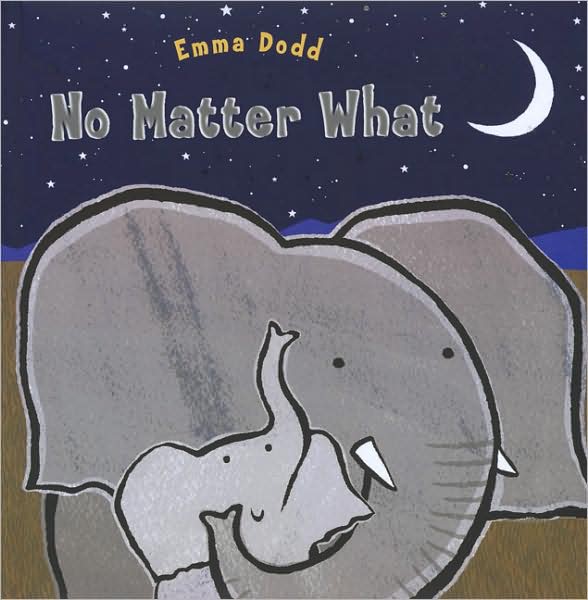 Earlly Literacy Aside--Explain: Welcome. Today we are going to have stories that have elephants in them. [Show elephant puppet] I am also going to highlight vocabulary as a fun way to help your child get ready to read. The more words they know, the easier it will be for them to understand what they read and also to make sense of words as they sound out words.Early Literacy Aside--Example: Very young children learn the names of things they see or see pictures of, like elephant, flowers, mouse. As they get older they understand words for feelings and concepts like sad, happy, good, bad, big elephant, little elephant. And older still, they understand words for ideas like brave, kind, mean. These are examples of ways you can develop your child's vocabulary daily in a fun way. You can use books to help develop all levels of vocabulary. Listen to some of the words as I read our next book.
Read No Matter What
Early Literacy Aside--Empower: The library has many books with opposites, feelings, and other concepts to help you have fun with vocabulary development with your child. Books from naming items to talking about ideas. Just ask us for some suggestions.
Earlly Literacy Aside--Explain: Welcome. Today we are going to have stories that have elephants in them. [Show elephant puppet] I am also going to highlight vocabulary as a fun way to help your child get ready to read. The more words they know, the easier it will be for them to understand what they read and also to make sense of words as they sound out words.Early Literacy Aside--Example: Very young children learn the names of things they see or see pictures of, like elephant, flowers, mouse. As they get older they understand words for feelings and concepts like sad, happy, good, bad, big elephant, little elephant. And older still, they understand words for ideas like brave, kind, mean. These are examples of ways you can develop your child's vocabulary daily in a fun way. You can use books to help develop all levels of vocabulary. Listen to some of the words as I read our next book.
Read No Matter What
Early Literacy Aside--Empower: The library has many books with opposites, feelings, and other concepts to help you have fun with vocabulary development with your child. Books from naming items to talking about ideas. Just ask us for some suggestions. Early Literacy Aside--Explain: Hello, parents. Today in storytime we are highlighting one of the early literacy skills, phonological awareness. This is the ability to hear and play with the smaller sounds in words including rhyming, beginning sounds and today we'll be doing animal sounds. Developing this skill will help children later sound out words as they learn to read.As you read Cock-a-Moo-Moo, note when the rooster crows that the font is large which means to use a LOUD voice. Point out the words for the corresponding sounds. Conclude the story by having the children say cock-a-doodle-do loudly to convey the rooster getting it right.
Early Literacy Aside--Example: Hearing and learning animal sounds helps children hear the smaller sounds in words too.
Early Literacy Aside--Empower: Hearing the rhythm of language and making the sounds of animals, both of these contribute to phonological awareness, hearing the smaller sounds in words, one of the skills that researchers have found helps with reading later on. Take opportunities during the course of the day to point out and to imitate sounds you hear, a car horn, the doorbell ringing, and so forth.
Early Literacy Aside--Explain: Hello, parents. Today in storytime we are highlighting one of the early literacy skills, phonological awareness. This is the ability to hear and play with the smaller sounds in words including rhyming, beginning sounds and today we'll be doing animal sounds. Developing this skill will help children later sound out words as they learn to read.As you read Cock-a-Moo-Moo, note when the rooster crows that the font is large which means to use a LOUD voice. Point out the words for the corresponding sounds. Conclude the story by having the children say cock-a-doodle-do loudly to convey the rooster getting it right.
Early Literacy Aside--Example: Hearing and learning animal sounds helps children hear the smaller sounds in words too.
Early Literacy Aside--Empower: Hearing the rhythm of language and making the sounds of animals, both of these contribute to phonological awareness, hearing the smaller sounds in words, one of the skills that researchers have found helps with reading later on. Take opportunities during the course of the day to point out and to imitate sounds you hear, a car horn, the doorbell ringing, and so forth.

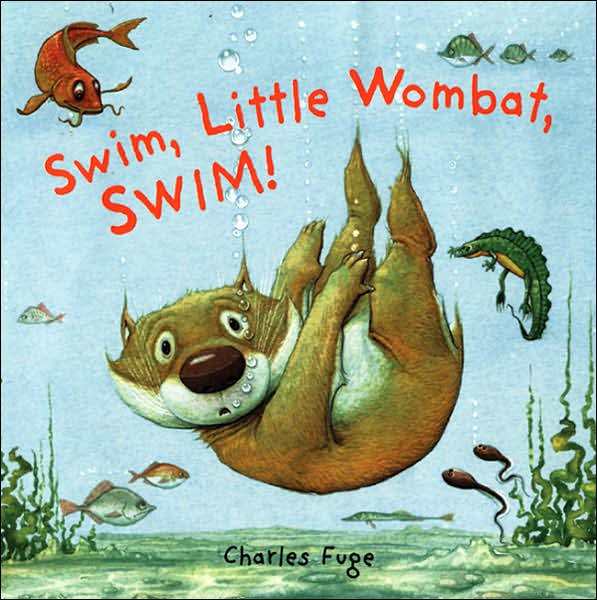 Early Literacy Aside--Explain: Today we are going to be reading stories about Australia. We're going to be hearing about a lot of new animals and learning a lot of new words. Those new words PLUS all the words you already know are vocabulary. If children have a good vocabulary, know a lot of words, which they learn from you and from books, it will be a lot easier for them to understand what they are reding when they learn to read. It starts NOW! That's why today, as we read about all these new animals, we're going to be learning about vocabulary, too.As you read Swim, Little Wombat, Swim use the pictures to explain unfamiliar words.
The furry little wombat is something like a pig with a grumpy nature and an awful urge to dig, complete with claws made mighty and strong for moving tons of dirt along . . .
Early Literacy Aside--Example: This story had a lot of words you might never use in everyday conversation. By using the words in the story and not replacing them with more familiar words, your child's vocabulary will grow. Also, they learn to use the pictures to get an idea of what the word means.
Early Literacy Aside--Empower: Now that you've heard all these stories about Australian animals like the platypus and the wombat, you all can look at these factual books with photographs of Australian animals that I have pulled from the shelves. You and your children can use your new vocabulary and you might even learn some more new words to use as you share these books together.
Early Literacy Aside--Explain: Today we are going to be reading stories about Australia. We're going to be hearing about a lot of new animals and learning a lot of new words. Those new words PLUS all the words you already know are vocabulary. If children have a good vocabulary, know a lot of words, which they learn from you and from books, it will be a lot easier for them to understand what they are reding when they learn to read. It starts NOW! That's why today, as we read about all these new animals, we're going to be learning about vocabulary, too.As you read Swim, Little Wombat, Swim use the pictures to explain unfamiliar words.
The furry little wombat is something like a pig with a grumpy nature and an awful urge to dig, complete with claws made mighty and strong for moving tons of dirt along . . .
Early Literacy Aside--Example: This story had a lot of words you might never use in everyday conversation. By using the words in the story and not replacing them with more familiar words, your child's vocabulary will grow. Also, they learn to use the pictures to get an idea of what the word means.
Early Literacy Aside--Empower: Now that you've heard all these stories about Australian animals like the platypus and the wombat, you all can look at these factual books with photographs of Australian animals that I have pulled from the shelves. You and your children can use your new vocabulary and you might even learn some more new words to use as you share these books together.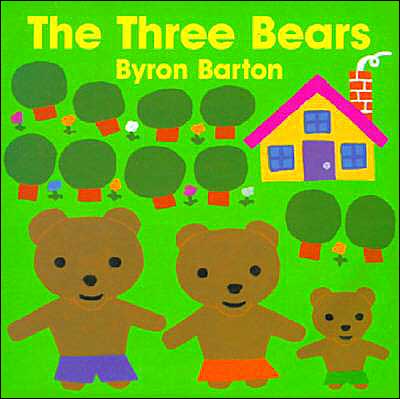 Early Literacy Aside--Explain: Narrative skills is the ability to talk about events and tell stories. Having children tell you what they are thinking, talk about things that happen, or tell you stories is later going to help them understand what they read.Read The Three Bears and have children help you retell the story using props or a flannel board.
Early Literacy Aside--Example: Retelling stories helps children understand what they read. Using props found around home can help children remember and retell stories.
Early Literacy Aside--Empower: When children do what is called dramatic play, when they act out stories, this kind of play helps children understand the structure and story and helps them understand the story itself. Play is a great way to support later reading.
Early Literacy Aside--Explain: Narrative skills is the ability to talk about events and tell stories. Having children tell you what they are thinking, talk about things that happen, or tell you stories is later going to help them understand what they read.Read The Three Bears and have children help you retell the story using props or a flannel board.
Early Literacy Aside--Example: Retelling stories helps children understand what they read. Using props found around home can help children remember and retell stories.
Early Literacy Aside--Empower: When children do what is called dramatic play, when they act out stories, this kind of play helps children understand the structure and story and helps them understand the story itself. Play is a great way to support later reading. Early Literacy Aside--Explain: Talking with children as you read books and share rhymes can add to the words they know and to their knowledge if YOU use words they are not familiar with or add information they may not yet know. Both adding to their vocabulary and to their knowledge will help them understand what they read when they learn to read. Say/sing the rhyme with actions:
The itsy bitsy spider went up the waterspout.
Down came the rain and washed the spider out.
Out came the sun and dried up all the rain.
And the itsy bitsy spider climbed up the spout again.
Early Literacy Aside--Example: Here are some examples of the kinds of questions you can ask your children. Then add to what they say to introduce new words and information. [Then you ask the children a couple of questions. Some possibilities are below. Be careful to keep it fun and engaging, not like a test of knowledge.]
Where was the spider going?
What happened when the rain started?
Where do you think spiders live?
Have you seen a spider? Where? What was it doing?
What do you know about spiders?
Early Literacy Aside--Empower: Sometimes we do not know much about some of the topics our children are interested in. We have lots of factual books on a variety of topics like spiders, snakes, dinosaurs, trains, and more. Just let us know what you and your children would like to read about. These books not only make reading enjoyable because yuou are building on your child's interest, you are also setting a good foundation for helping them learn new words and knowledge.
Early Literacy Aside--Explain: Talking with children as you read books and share rhymes can add to the words they know and to their knowledge if YOU use words they are not familiar with or add information they may not yet know. Both adding to their vocabulary and to their knowledge will help them understand what they read when they learn to read. Say/sing the rhyme with actions:
The itsy bitsy spider went up the waterspout.
Down came the rain and washed the spider out.
Out came the sun and dried up all the rain.
And the itsy bitsy spider climbed up the spout again.
Early Literacy Aside--Example: Here are some examples of the kinds of questions you can ask your children. Then add to what they say to introduce new words and information. [Then you ask the children a couple of questions. Some possibilities are below. Be careful to keep it fun and engaging, not like a test of knowledge.]
Where was the spider going?
What happened when the rain started?
Where do you think spiders live?
Have you seen a spider? Where? What was it doing?
What do you know about spiders?
Early Literacy Aside--Empower: Sometimes we do not know much about some of the topics our children are interested in. We have lots of factual books on a variety of topics like spiders, snakes, dinosaurs, trains, and more. Just let us know what you and your children would like to read about. These books not only make reading enjoyable because yuou are building on your child's interest, you are also setting a good foundation for helping them learn new words and knowledge. Early Literacy Aside--Explain: Today we're going to highlight narrative skills. This is the ability to describe things and to talk about events and tell stories. Researchers have noted this skill as one of the early literacy skills that will help your child be ready to read. It helps children
Early Literacy Aside--Explain: Today we're going to highlight narrative skills. This is the ability to describe things and to talk about events and tell stories. Researchers have noted this skill as one of the early literacy skills that will help your child be ready to read. It helps children 
 Early Literacy Aside--Explain: Researchers have found that one of ways you can support later reading is by helping children hear the smaller sounds in words. This skill is called phonological awareness. Today I'll point out some thing you can do to help your childrne develop this skill.Early Literacy Aside--Example: Rhyming is one way that children learn to hear that words are made up of smaller parts. By doing rhymes with your children you are setting the stage for them to sound out words to read.
Read Train Song
Early Literacy Aside--Empower: Find a book at home which has rhyming words and see if your child can identify words that rhyme. If you don't have a rhyming book, just read a book and then pick a word and think of rhyming words together.
Early Literacy Aside--Explain: Researchers have found that one of ways you can support later reading is by helping children hear the smaller sounds in words. This skill is called phonological awareness. Today I'll point out some thing you can do to help your childrne develop this skill.Early Literacy Aside--Example: Rhyming is one way that children learn to hear that words are made up of smaller parts. By doing rhymes with your children you are setting the stage for them to sound out words to read.
Read Train Song
Early Literacy Aside--Empower: Find a book at home which has rhyming words and see if your child can identify words that rhyme. If you don't have a rhyming book, just read a book and then pick a word and think of rhyming words together.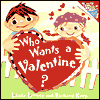 Early Literacy Aside--Explain: Researchers have found that children with a large vocabulary, who have heard a lot of different words, find it easier to learn to read when the time comes.Read Who Wants a Valentine?
Early Literacy Aside--Example: Don't replace unfamiliar words, use them and explain them if necessary. For example: "Tea for two?/ I decline./ I don't want a valentine." I didn't change the word decline, I explained it: decline means to say no.
Early Literacy Aside--Explain: Researchers have found that children with a large vocabulary, who have heard a lot of different words, find it easier to learn to read when the time comes.Read Who Wants a Valentine?
Early Literacy Aside--Example: Don't replace unfamiliar words, use them and explain them if necessary. For example: "Tea for two?/ I decline./ I don't want a valentine." I didn't change the word decline, I explained it: decline means to say no.
 Early Literacy Aside--Explain: We are going to have fun playing with sounds today, reading stories with sound words. Playing with sounds helps develop phonological awareness which will help your child learn to hear the smaller sounds in words.Read book emphasizing sound words like crunch and munch. Then I go back to some pages and have the children say the words with me, again emphasizing different sounds.
Early Literacy Aside--Example: Hearing and learning sound words like splish-splash is an enjoyable way of learning phonlogical awareness and will help your children later hear smaller sounds in words.
Early Literacy Aside--Empower: At home, play with sound words, like splish-splash in the bath, crunch-munch at snack, and exaggerate how you are saying words to practice hearing their parts.
Early Literacy Aside--Explain: We are going to have fun playing with sounds today, reading stories with sound words. Playing with sounds helps develop phonological awareness which will help your child learn to hear the smaller sounds in words.Read book emphasizing sound words like crunch and munch. Then I go back to some pages and have the children say the words with me, again emphasizing different sounds.
Early Literacy Aside--Example: Hearing and learning sound words like splish-splash is an enjoyable way of learning phonlogical awareness and will help your children later hear smaller sounds in words.
Early Literacy Aside--Empower: At home, play with sound words, like splish-splash in the bath, crunch-munch at snack, and exaggerate how you are saying words to practice hearing their parts. Early Literacy Aside--Explain: Research shows that there are early literacy skills that influence a child's ability to learn to read. Today, you will probably notice several places where I demonstrate examples of narrative skills, which is the ability to describe things and events and to tell stories. When you develop this skill, it will help your children understand what they reads later.Song: Bop 'Til You Drop
Go through the sequence of motions that are in the song, Bop 'Til You Drop
Early Literacy Aside--Example: Singing songs that have a certain order is one great way for children to remember the sequence or order of things. They will use the same skill when they retell a story. They learn how stories work.
Early Literacy Aside--Empower: One thing that you can do at home to develop narrative skills is to describe regular activities such as taking a bath--"first we'll get out the towel, then we'll put the water in the tub and add the bubbles/toys, then we'll take off your clothes, and get in the water. We can scrub our toes, our ears . . . " With older kids, let THEM describe the sequence of events with prompts like, "What do we have to do before we put the bubbles in? or "What do we do next?"
Early Literacy Aside--Explain: Research shows that there are early literacy skills that influence a child's ability to learn to read. Today, you will probably notice several places where I demonstrate examples of narrative skills, which is the ability to describe things and events and to tell stories. When you develop this skill, it will help your children understand what they reads later.Song: Bop 'Til You Drop
Go through the sequence of motions that are in the song, Bop 'Til You Drop
Early Literacy Aside--Example: Singing songs that have a certain order is one great way for children to remember the sequence or order of things. They will use the same skill when they retell a story. They learn how stories work.
Early Literacy Aside--Empower: One thing that you can do at home to develop narrative skills is to describe regular activities such as taking a bath--"first we'll get out the towel, then we'll put the water in the tub and add the bubbles/toys, then we'll take off your clothes, and get in the water. We can scrub our toes, our ears . . . " With older kids, let THEM describe the sequence of events with prompts like, "What do we have to do before we put the bubbles in? or "What do we do next?" Early Literacy Aside--Example: Print motivation is an interest in and enjoyment of books. Children need this skill prior to formal reading instruction. One way to develop this skill is to use pop-up books and other books that provide surprises. Let's see what surprises this book brings.Read Wide-Mouthed Frog.
Early Literacy Aside--Example: Print motivation is an interest in and enjoyment of books. Children need this skill prior to formal reading instruction. One way to develop this skill is to use pop-up books and other books that provide surprises. Let's see what surprises this book brings.Read Wide-Mouthed Frog.